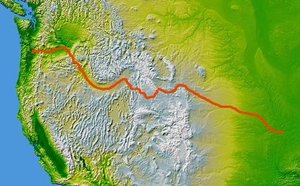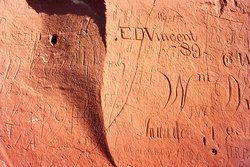Oregon Trail
|
|
For other uses of the term, see Oregon Trail (disambiguation)
Oregontrail_1907.jpg
Oregon_Trail_ruts.jpg
The Oregon Trail was one of the key overland migration routes on which pioneers traveled across the North American continent in wagons in order to settle new parts of the United States of America during the 19th century. The Oregon Trail helped the United States implement its cultural goal of Manifest Destiny, that is to build a great nation spanning the North American continent. The Oregon Trail spanned over half the continent as the wagon trail proceeded over 2,000 miles west through territories and land later to become six U.S. states (Missouri, Kansas, Nebraska, Wyoming, Idaho, and Oregon). Between 1841 and 1869, the Oregon Trail was used by settlers to the Northwest and West Coast areas of what is now the United States. Once the first transcontinental railroad was completed in 1869, this trail was no longer used by long-distance travelers.
| Contents |
History
The first land route across the continent to be well-mapped was that taken by Lewis and Clark from 1804 to 1805. They believed they had found a practical route to the west coast. However, the pass through the Rocky Mountains they took, Lolo Pass, turned out to be too difficult for wagons to pass. In 1810, John Jacob Astor outfitted an expedition to find an overland supply route for establishing a fur trading post at the mouth of the Columbia River. The expedition was a failure, but on the way back, the party discovered a wide, low pass through the Rockies: South Pass.
Westward expansion did not begin immediately, however. Reports from expeditions in 1806 by Lt. Zebulon Pike and in 1819 by Maj. Steven Long described the Great Plains as "unfit for human habitation" and "the Great American Desert". These descriptions ignored the fact that the land could be fertile if irrigated with ground water (the Great Plains are a major farming area today). Regardless, the images they conjured up of a wasteland of sand and cactus discouraged migration for some time.
The route of the Oregon Trail began to be scouted out as early as 1823 by fur traders and explorers. The trail began to be regularly used by fur traders, missionaries, and military expeditions during the 1830s. At the same time, small groups of individuals and the occasional family attempted to follow the trail and some succeeded in arriving at Fort Vancouver in Washington. On May 16, 1842 the first organized wagon train on the Oregon Trail set out from Elm Grove, Missouri, with more than 100 pioneers. (Members of the party later disagreed over the size of the party, one stating 160 adults and children were in the party, while another counted only 105.) Despite company policy to discourage U.S. emigration, John McLoughlin, Factor of the Hudson's Bay Company at Fort Vancouver, offered the American settlers food and farming equipment on credit, being unwilling to watch able-bodied people to starve. The following year, an estimated 800 immigrants arrived in the Willamette Valley. Hundreds of thousands more would follow, especially after gold was discovered in California in 1849. The trail was still in use during the Civil War, but traffic declined after 1869 when the transcontinental railroad was completed. The trail continued to be used into the 1890s and modern highways eventually paralleled large portions of the trail.
Other migration paths for early settlers prior to the establishment of the transcontinental railroads involved taking passage on a ship rounding the Cape Horn of South America or to the Isthmus (now Panama) between North and South America. There, an arduous mule trek through hazardous swamps and rain forests awaited the traveler. A ship was typically then taken to San Francisco, California.
Routes
While the first few parties organized and departed from Elm Grove, the Oregon Trail's generally designated starting point was Independence or Westport on the Missouri River. The Oregon Trail's designated termination point was Oregon City, at the time the proposed capital of the Oregon Territory. However, many settlers branched off or grew exhausted short of this goal and settled at convenient or promising locations along the trail. Commerce with pioneers going further west greatly assisted these early settlements in getting established and launched local micro-economies critical to these settlements' prosperity.
Pioneers on the Oregon Trail followed various rivers and used landmarks along the trail to guide their way and gauge their progress. Within Nebraska, the Oregon Trail followed the Platte River and then the North Platte River into Wyoming. Along this part of the journey, the Great Plains started giving way to bluffs and hills that were the precursor of the Rocky Mountains. After crossing the Rockies through South Pass, the trail followed the Snake River to the Columbia River. From there, emigrants had the option of either rafting down the Columbia to Fort Vancouver, or taking the Barlow Road to the Willamette Valley and other destinations in what are now the states of Washington and Oregon.
At many places along the trail, alternate routes called "cutoffs" were established, either to shorten the trail, or to get around difficult terrain. The Lander and Sublette cutoffs provided shorter routes through the mountains than the main route, bypassing Fort Bridger. In later years, the Salt Lake cutoff provided a route to Salt Lake City.
A number of other trails followed the Oregon Trail for part of its length. These include the Mormon Trail from Illinois to Utah, and the California Trail to the gold fields of California.
The modern-day U.S. Highway 26 follows the Oregon Trail for much of its length.
Signature_Cliffs2.jpg
Landmarks
Many rock formations became famous landmarks that the Oregon Trail pioneers used to navigate as well as leave messages for pioneers following behind them. The first landmarks that the pioneers encountered were in Western Nebraska, such as Courthouse and Jail Rocks, Chimney Rock, and Scotts Bluff (where wagon ruts can still be seen to this day). Further west, in Wyoming, you can still read the names that these pioneers carved into a landmark bluff called Register Cliff. One Wyoming landmark along the trail, Ayres Natural Bridge, is now a state park of the same name.
Travel equipment
The Oregon Trail was too long and arduous for the standard Conestoga wagons used in the Eastern U.S. at that time for most freight transport. These big wagons had a reputation for killing their oxen teams approximately two thirds along the trail and leaving their unfortunate owners stranded in desolate, isolated territory. The only solution was to abandon all belongings and traipse onward with the supplies and tools that could be carried or dragged. In one case in 1846 the Donner Party, en route to California, was stranded in the Sierra Nevada in November and had to resort to cannibalism to survive.
This led to the rapid development of the prairie schooner. This wagon was approximately half the size of the big Conestogas but was also manufactured in quantity by the Conestoga Brothers. It was designed for the Oregon Trail's conditions and was a marvel of engineering in its time.
See also
External links
- Oregon or the Grave (http://oregonmag.com/OrHistArticle.htm)
- Historic Sites on the Oregon Trail (http://www.isu.edu/~trinmich/Sites.html)
- Oregon Trail History Library (http://www.endoftheoregontrail.org/histhome.html)
- Oregon Trail: The Trail West (http://www.ku.edu/kansas/seneca/oregon/mainpage.html)
- Oregon National Historic Trail Home Page (http://www.nps.gov/oreg)
- Oregon Trail Map 1843 (http://www.rootsweb.com/~orgenweb/1843trailmap.html)de:Oregon Trail


